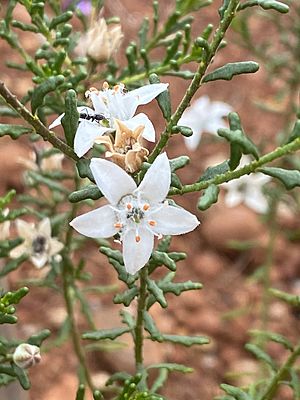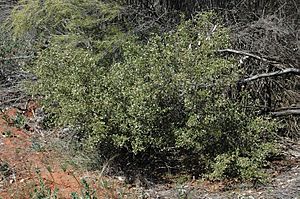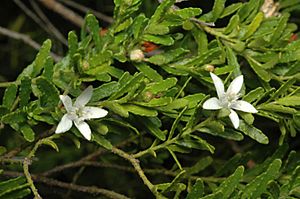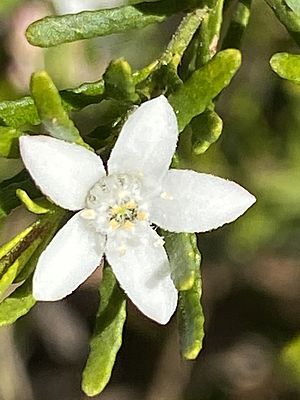Philotheca difformis facts for kids
Quick facts for kids Philotheca difformis |
|
|---|---|
 |
|
| Philotheca difformis subsp. difformis | |
| Scientific classification | |
| Genus: |
Philotheca
|
| Species: |
difformis
|
| Synonyms | |
|
|

Philotheca difformis is a cool flowering plant that belongs to the family Rutaceae, which also includes citrus fruits! This shrub is special because it's endemic to eastern Australia, meaning it naturally grows only there. It has different leaf shapes depending on its type (called a subspecies), and it shows off pretty white flowers. These flowers grow either by themselves or in small groups at the ends of its branches. One of its types, subspecies difformis, is often called the small-leaf wax-flower.
What It Looks Like
Philotheca difformis is a shrub that usually grows about 1 to 2 meters tall. Its small branches have tiny bumps that look like glands or warts. The leaves are thick and smooth, and they also have these small bumps. They grow on a short stem called a petiole.
The leaves look different depending on the subspecies:
- Subspecies difformis has thick, more or less round leaves, about 8 millimeters long and 1 millimeter wide.
- Subspecies smithiana has flat, somewhat egg-shaped leaves, about 4 millimeters long and 2 millimeters wide.
The flowers grow alone or in small groups of two to four at the ends of the branches. Each flower sits on a tiny stem called a pedicel, which is about 2 to 3 millimeters long. There are five thick, triangle-shaped sepals (these are like small leaves that protect the flower bud). There are also five long, white petals, each about 4 to 5 millimeters long, with a thick line down the middle. Inside the flower, there are ten stamens (the parts that make pollen), and they are covered in soft hairs.
This plant can flower at different times throughout the year. Its fruit is about 5 millimeters long, has bumps, and looks like it has a small beak.
How This Plant Got Its Name
This plant was first officially described in 1837 by a scientist named Stephan Endlicher. He used notes from another botanist, Allan Cunningham, who had given it the name Eriostemon difformis. Endlicher published this description in a book called Enumaratio plantarum.
Allan Cunningham collected the first samples of this plant (called the type specimens) on May 24, 1817. He found them in a dry area near the Lachlan River during an expedition led by John Oxley.
Later, in 1998, another scientist named Paul G.Wilson changed the plant's name to Philotheca difformis. He also described two different types, or subspecies:
- Philotheca difformis subsp. difformis
- Philotheca difformis subsp. smithiana
Where It Grows
Philotheca difformis subspecies difformis likes to grow in rocky areas within woodlands. You can mostly find it in the inland parts of:
- South-east Queensland
- Inland New South Wales
- North-west Victoria
- The Flinders Ranges in South Australia
Subspecies smithiana often grows on rocky outcrops (places where rocks stick out of the ground). It is found closer to the coast in:
- South-east Queensland
- North-eastern New South Wales, as far south as Singleton



